Filters are configurable components of GeoEvent Services that filter (remove from the streaming data) GeoEvents that do not satisfy specified criteria. Filters are generally attribute filters, spatial filters or a combination of both attribute and spatial, although GeoEvent Server product macros such as $DEFINITION_NAME, for example, enable GeoEvent filtering by properties (such as the name of the GeoEvent Definition associated with the current GeoEvent).
Attribute filters
Attribute filters in a GeoEvent Service filter events based on attribute criteria. An attribute filter can be configured with one or more attribute expressions. The logical combination of these expressions represents the criteria a GeoEvent must satisfy to pass through the filter.
The following attribute operators are supported:
- Equal (=)—This operator retains GeoEvents whose attribute values equal a specified value. For example, IdString = 3XAB891
- Not Equal (!=)—This operator retains GeoEvents whose attribute values do not equal a specified value. For example, StatusString != Err.
Note:
The Equals and Not Equal operators should not be applied to floating point values. For example, do not configure a filter expression like Radius = 3.14159, instead use the Greater Than, Less Than, or other operator.
- Greater Than (>)— This operator retains GeoEvents whose attribute values are greater than a specified value. For example, Speed > 50.
- Greater Or Equal (>=)—This operator retains GeoEvents whose attribute values are greater than or equal to a specified value. For example, Speed >= 50.
- Less Than (<)—This operator retains GeoEvents whose attribute values are less than a specified value. For example, Altitude < 1000.
- Less Or Equal (<=)—This operator retains GeoEvents whose attribute values are less than or equal to a specified value. For example, Altitude <= 1000.
Note:
The Greater Than, Less Than, and other operators should not be applied to string values. For example do not configure a filter expression like Company > ABC, instead use the Equals or Not Equal operator and incorporate the entire string into the expression.
- IN— This operator retains GeoEvents when a specified field's value exists in a comma-separated list of values. For example, StatusCode IN HK1,HK3,HK5.
- MATCHES—This operator retains GeoEvents when a specified field's value matches a regular expression. For example, StatusCode MATCHES ^HK[135].
Note:
The specified regular expression is evaluated as either matching or not matching the entire event field value; partial matches are not supported. In the example above, if the StatusCode contained additional characters beyond the single numeric digit, the expression would need to include .* to match any trailing characters in the attribute value.
- EXISTS—This operator retains GeoEvents when a specified field exists in the received event's schema. For example, Geometry EXISTS.
- ISNULL—This operator retains GeoEvents when a specified field contains a null value. For example, Geometry ISNULL.
Note:
Checking for NULL strings is not supported. GeoEvent defines a string as empty (a zero-length string) rather than as a null object.
Spatial filters
Spatial filters in a GeoEvent Service filter GeoEvents based on a spatial relationship with a geofence. The geometries that specify a geofence must be imported into GeoEvent Server from a published feature service before a spatial filter can be configured.
The following spatial operators are supported:
- INSIDE—A GeoEvent's geometry is considered to be inside a geofence if its geometry is entirely within the area defined by the geofence. This operator can determine whether a point associated with a GeoEvent is inside an area of interest.
- OUTSIDE—A GeoEvent's geometry is considered to be outside a geofence if its geometry is entirely outside the area defined by the geofence. This operator can determine whether a point associated with a GeoEvent is outside an area of interest.

- ENTER—A GeoEvent's geometry is considered to have entered a geofence if its geometry is now inside the area defined by the geofence, when the previous GeoEvent position, from the same track, was outside the geofence. After an enter condition is detected and the GeoEvent is allowed to pass through the filter, the tracked object must report at least one event outside the geofence before another enter will be recognized.
- EXIT—A GeoEvent's geometry is considered to have exited a geofence if its geometry is now outside the area defined by the geofence, when the previous GeoEvent position, from the same track, was inside the geofence. After an exit condition is detected and the GeoEvent is allowed to pass through the filter, the tracked object must report at least one event inside the geofence before another exit will be recognized.
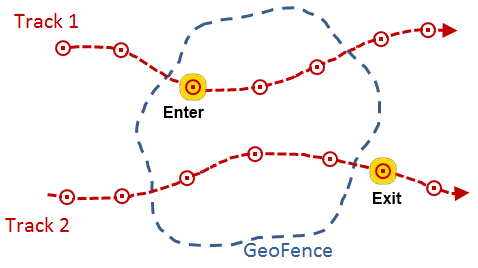
Note:
The EXISTS and ISNULL attribute operators above are also applicable when a Geometry field is specified as part of a spatial filter's expression.
Typically a set of geofences define areas of interest and are imported from a feature service providing polygon features. Geofences do not always have to represent polygonal areas, they can be imported from point and line features as well.
The spatial operators below can be used with different types of geometries. These spatial operators return a Boolean, indicating whether or not the described relationship exists between a geofence and a GeoEvent's geometry. Some relationships require that a GeoEvent's geometry have the same dimension as the geofence to which it is being compared, while others have more flexible dimensional constraints. Many of the spatial operators below are mutually exclusive Clementini operators.
- CONTAINS—An event's geometry will contain a geofence if the geofence is a subset of the event's geometry and the intersection of the two geometries is not empty. Contains is the logical opposite of Within. It is not possible for a point geometry to contain a polyline or polygon, so it is not possible for a point associated with an event to contain a line or area imported as a geofence. It is possible for a point to contain a point or a line to contain a line, but testing for such a spatial relationship is not recommended. Trivial differences in a geometry due to projection may result in a point or line you expect to be coincident with a geofence not actually being perfectly coincident (in which case the Contains relationship will evaluate as false).
See IRelationalOperator.Contains Method in the ArcObjects API Reference for .NET for more information on the Contains operator.
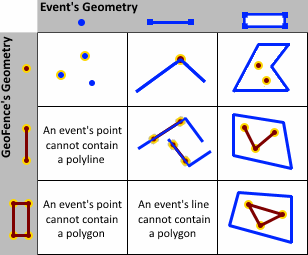
- CROSSES—An event's geometry crosses a geofence if an
intersection exists in a geometry of a lesser dimension. Two
polylines cross if they intersect at one or more points and at
least one point is not an endpoint. A polyline and an polygon cross
if they share a polyline or a point on the interior of the polygon
which is not equivalent to the entire polyline. Crosses only applies to polyline/polyline,
polyline/polygon, or polygon/polyline relations. If either one of the geometries is empty, the
geometries do not cross.
See IRelationalOperator.Crosses Method in the ArcObjects API Reference for .NET for more information on the Crosses operator.
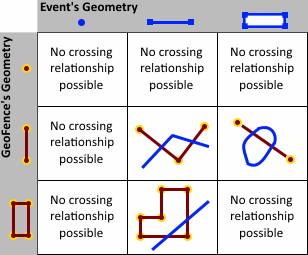
- DISJOINT—An event's geometry is considered to be
disjoint from a geofence if the two geometries do not intersect.
Note that an event's geometry can be disjoint from one geofence
while it intersects another geofence. Take care when specifying a
spatial expression. The expression will specify not only the
event's geometry, but also a scope, either any or all, and a set of
geofences identified using a regular expression pattern match
(e.g.
SomeCategory/.*).
See IRelationalOperator.Disjoint Method in the ArcObjects API Reference for .NET for more information on the Disjoint operator.

- EQUALS—An event's geometry equals a geofence's geometry if their symmetric difference is the empty set. If you were to iterate over each segment in each geometry and compare the segment's type and coordinates, and found they were the same (using the spatial reference's cluster tolerances to determine equality of coordinates), the two geometries would be considered equal.
See IRelationalOperator.Equals Method in the ArcObjects API Reference for .NET for more information on the Equals operator.
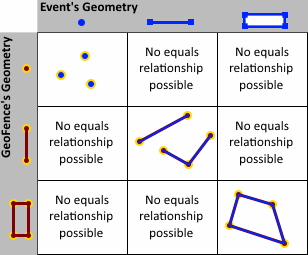
- INTERSECTS—An event's geometry intersects a geofence if the two geometries are not disjoint. Intersects is the logical opposite of Disjoint. An event's point which is within a geofence's area (polygon) also intersects the geofence. An event's polyline or polygon can intersect a geofence without being entirely within the geofence. An event's geometry can intersect one geofence within a set of geofences and still be DISJOINT ANY (for example, disjoint one or more). The event's geometry is not DISJOINT ALL since it intersects at least one of the geofences in the set.
- OVERLAPS—An event's geometry overlaps a geofence if an
intersection exists whose dimension is the same as the geometries
being considered and the intersection is not equivalent to either
the event's geometry or the geofence.
Overlaps only apply to polyline/polyline,
polygon/polygon, and multipoint/multipoint relations. If either one of the geometries is empty, the
geometries do not overlap.
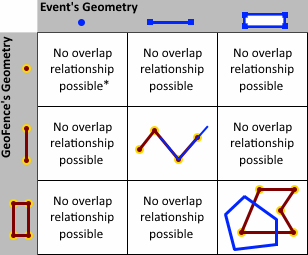
* Point geometries fail the equivalency condition, so an event's point location cannot overlap a geofence whose geometry is also a point.
- TOUCHES—An event's geometry touches a geofence if an
intersection exists and the interior of the intersection is
empty. This means two geometries only touch at vertices
which define the geometry, not at a points in between
vertices. Touches is undefined for point/point
relations. If either one of the geometries is empty, the
geometries do not touch.
See IRelationalOperator.Touches Method in the ArcObjects API Reference for .NET for more information on the Touches operator.
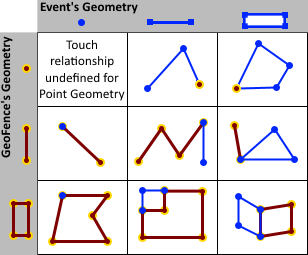
- WITHIN—An event's geometry is considered to be within a geofence if the two geometries intersect and the intersection of their interiors is not empty. Within is the logical opposite of Contains.
See IRelationalOperator.Within Method in the ArcObjects API Reference for .NET for more information on the Within operator.
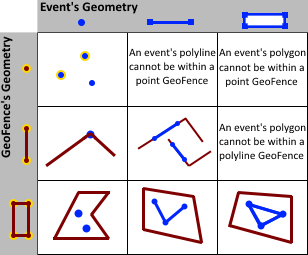
For more information on the relational operators, see IRelationalOperator Interface in the ArcObjects API Reference for .NET
For more information on working with geofences in GeoEvent Server, see Managing geofences.
GeoEvent property filters
Every GeoEvent in GeoEvent Server has an associated set of properties such as the GeoEvent Definition used to construct the GeoEvent. Recall that a GeoEvent Definition is a schema that identifies the attribute fields and data types—date, string, integer, and so forth—for the GeoEvent's data. A filter can be configured to filter GeoEvents based on their properties such as their GeoEvent Definition.
When configuring a filter expression, the drop-down for the Field parameter displays a list of field names from available GeoEvent Definitions. At the top of this list are several GeoEvent Server properties including:
- $OWNER_ID
- $OWNER_URI
- $DEFINITION_NAME
- $DEFINITION_GUID
- $RECEIVED_TIME
Constructing a filter with the following expression would discard any GeoEvents that do not contain the Flights-TcpTextIn GeoEvent Definition name: $DEFINITION_NAME = Flights-TcpTextIn. A filter like this one that is based on a GeoEvent Definition property could be used to filter any GeoEvents that do not adhere to a required schema.
Configuring filters using tags
A tag is a label placed on a particular field of a GeoEvent Definition. Tags are similar to field aliases; they support consistency in expressions when different GeoEvent Definitions associate similar data with different field names. Certain built-in tags identify important GeoEvent Server fields that contain information such as a TRACK_ID or GEOMETRY.
Once a tag has been created and applied to a particular field of a GeoEvent Definition, filters can reference a field by its tag rather than by the field’s name. This is particularly useful when configuring an attribute filter because it allows a single attribute filter to apply the exact same attribute-based criteria to multiple types of events.
See Managing tags to learn more about using tags in GeoEvent Server.
Configuring filters using regular expressions
The MATCHES operator—available when configuring an attribute filter—supports the use of regular expressions to find a pattern within a target field. Regular expression pattern matching can be a powerful tool for data validation. The full scope and syntax of regular expressions cannot be covered within this topic, but the examples below help illustrate their use in GeoEvent filters.
Note:
Regular expressions can only be applied to attribute fields of type string.
Note:
The specified pattern is matched against the entire string. You cannot enter California to match strings that contain that substring. Specifying a pattern .*California.* accounts for zero or more characters both before and after the substring the filter is supposed to find.
| Field value | RegEx pattern | Result |
|---|---|---|
SWA2382 | | The carat sign (^) anchors the pattern to the beginning of the string, and a dollar sign ($) anchors the pattern to the end of the string. The [0-9]+ portion of the pattern specifies that one or more digits 0 through 9 should be found at the end of the string. Any values in the target field that do not begin with SWA, followed by some number of digits representing a flight number, will be discarded by the filter. |
02/15/1973 | | The use of numeric ranges such as 0 through 1, 0 through 3, and 0 through 9 specifies the expected values for a mm/dd/yy date string. Values that do not have a two-digit month followed by a two-digit day and a four-digit year, separated by a slash (/), will be discarded by the filter. |
3.14159 | | This pattern verifies that the string in the target field can be interpreted as a numeric value. An asterisk (*) in the RegEx pattern matches zero or more instances of the preceding character; a question mark (?) matches zero or one instances. The backslash means that the '.' is a literal decimal point, not a wildcard (*). The pattern makes a plus (+) or minus (-) sign the integer portion of a floating point value and the literal decimal optional (may occur zero times). |